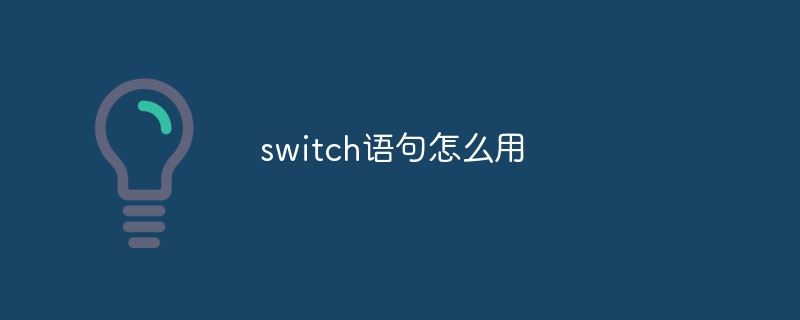PHP is a popular programming language commonly used to develop web applications. In PHP, conditional statements are an important part. Conditional statements allow a program to execute different blocks of code based on different conditions. In this article, we will introduce conditional statements in PHP and give some examples and usage tips.
- if statement
The if statement is one of the most commonly used conditional statements in PHP. Its basic usage is as follows:
if (条件) {
// 如果条件成立执行这里的代码
}The condition can be any expression, for example:
if ($x > 10) {
echo "x 大于 10";
}The above code will output "x is greater than 10" when $x is greater than 10 ".
The if statement also supports the else statement, which can execute additional code when the condition is not true. For example:
if ($x > 10) {
echo "x 大于 10";
} else {
echo "x 小于等于 10";
}The above code will output "x is less than or equal to 10" when $x is less than or equal to 10.
In addition to if and else, there is also an elseif statement, which can be used to choose between multiple conditions. For example:
if ($x > 10) {
echo "x 大于 10";
} elseif ($x < 10) {
echo "x 小于 10";
} else {
echo "x 等于 10";
}- switch statement
The switch statement is also a commonly used conditional statement, suitable for selecting between multiple options. The basic usage is as follows:
switch (表达式) {
case 值1:
// 如果表达式等于值1,则执行这里的代码
break;
case 值2:
// 如果表达式等于值2,则执行这里的代码
break;
default:
// 如果表达式不等于任何一个值,则执行这里的代码
}The following is an example:
$day = "星期三";
switch ($day) {
case "星期一":
echo "今天是星期一";
break;
case "星期二":
echo "今天是星期二";
break;
case "星期三":
echo "今天是星期三";
break;
default:
echo "今天不是工作日";
}The above code will output "Today is Wednesday".
- Ternary operator
The ternary operator is also a commonly used conditional statement, which can complete simple conditional judgments in one line of code. The basic usage is as follows:
$variable = (条件) ? 表达式1 : 表达式2;
If the condition is true, assign expression 1 to the variable, otherwise assign expression 2 to the variable. This can be used to set the value of a variable based on conditions. For example:
$age = 25; $message = ($age >= 18) ? "成年人" : "未成年人"; echo $message;
The above code will output "Adult".
- NULL coalescing operator
PHP7 introduces a new conditional statement: the NULL coalescing operator. It can be used to simplify the code that determines whether a variable is null. The basic usage is as follows:
$variable = $value ?? $default;
If $value is not null, assign it to $variable, otherwise assign $default to $variable. For example:
$username = $_GET["username"] ?? "guest"; echo $username;
The above code will output the user name obtained from the GET request, or "guest" if there is no user name.
Summary
This article introduces conditional statements in PHP, including if, switch, ternary operator and NULL coalescing operator. These conditional statements allow the program to execute different code blocks based on different conditions, thereby achieving more flexible logical judgments. When using conditional statements, you need to pay attention to the format of the conditional expression and code block to avoid syntax errors.
The above is the detailed content of How to use conditional statements in php?. For more information, please follow other related articles on the PHP Chinese website!
 计算机编程中常见的if语句是什么Jan 29, 2023 pm 04:31 PM
计算机编程中常见的if语句是什么Jan 29, 2023 pm 04:31 PM计算机编程中常见的if语句是条件判断语句。if语句是一种选择分支结构,它是依据明确的条件选择选择执行路径,而不是严格按照顺序执行,在编程实际运用中要根据程序流程选择适合的分支语句,它是依照条件的结果改变执行的程序;if语句的简单语法“if(条件表达式){// 要执行的代码;}”。
 PHP中的条件控制结构Mar 10, 2024 pm 09:36 PM
PHP中的条件控制结构Mar 10, 2024 pm 09:36 PMPHP中的条件控制结构在PHP编程中,条件控制结构是一种非常重要的语法,它可以让程序根据不同的条件来执行不同的代码块。通过使用条件控制结构,我们可以实现程序的分支逻辑,根据条件的结果来决定程序的执行路径。本文将介绍PHP中常用的条件控制结构,包括if语句、else语句、elseif语句和switch语句,并给出具体的代码示例。if语句是PHP中最基本的条件控
 如何解决Python的代码中的if语句重复错误?Jun 24, 2023 pm 04:10 PM
如何解决Python的代码中的if语句重复错误?Jun 24, 2023 pm 04:10 PMPython是一种十分强大且受欢迎的编程语言,被广泛应用于数据分析、机器学习和Web开发等领域。然而,在编写Python代码时,我们难免会遇到if语句重复的情况,这可能会导致代码效率低下、维护复杂等问题。因此,本文将介绍一些解决Python代码中if语句重复错误的方法和技巧。利用布尔运算符简化if语句在许多情况下,if语句中重复的逻辑可以被简化为布尔运算。例
 Go 语言基础 - switch语句Jul 24, 2023 pm 03:50 PM
Go 语言基础 - switch语句Jul 24, 2023 pm 03:50 PMswitch是一个条件语句,用于计算条件表达式的值,判断该值是否满足case语句,如果匹配则会执行相应的代码块。是用来替换复杂if-else语句的常用方式。
 switch语句Aug 11, 2023 am 10:54 AM
switch语句Aug 11, 2023 am 10:54 AMSwitch语句是一种在编程中常用的控制结构,允许程序根据不同的条件值来执行不同的代码块,可以代替多个if-else语句,提高代码的可读性和可维护性。虽然它有一些限制,但在适当的情况下,使用Switch语句可以使程序更加简洁和高效。
 Go 语言中的 switch 语句是怎样使用的?Jun 11, 2023 am 09:11 AM
Go 语言中的 switch 语句是怎样使用的?Jun 11, 2023 am 09:11 AMGo语言是一种新兴的编程语言,它具有高效、简洁、安全和并发等特点,非常适合用于Web开发、分布式系统和云计算等领域。在Go语言中,switch语句是一种非常常用的语言结构,它可以根据表达式的值,选择不同的分支进行执行。本文将介绍Go语言中switch语句的基本使用方法和注意事项。基本语法Go语言中的switch语句与其他编程语言中的
 switch语句怎么用Sep 21, 2023 pm 05:48 PM
switch语句怎么用Sep 21, 2023 pm 05:48 PMswitch语句用法:1、Switch语句只能用于整数类型,枚举类型和String类型,不能用于浮点数类型和布尔类型;2、每个case语句后面必须跟着一个break语句,以防止执行其他case的代码块,没有break语句,将会继续执行下一个case的代码块;3、可以在一个case语句中匹配多个值,使用逗号分隔;4、Switch语句中的default代码块是可选的等等。
 Java 枚举类型如何与 switch 语句配合使用?Apr 30, 2024 pm 06:48 PM
Java 枚举类型如何与 switch 语句配合使用?Apr 30, 2024 pm 06:48 PM枚举类型是Java中定义常量集合的数据类型。配合switch语句,可实现以下功能:清晰表示值范围:枚举类型用于定义一组不可变的常量值,提高代码可读性。匹配不同枚举常量:switch语句允许根据枚举常量执行不同的操作,实现精细化的控制。处理不同场景:通过枚举类型和switch语句,可以在实际场景中灵活处理各种情况,如不同的通知类型发送不同邮件内容。


Hot AI Tools

Undresser.AI Undress
AI-powered app for creating realistic nude photos

AI Clothes Remover
Online AI tool for removing clothes from photos.

Undress AI Tool
Undress images for free

Clothoff.io
AI clothes remover

AI Hentai Generator
Generate AI Hentai for free.

Hot Article

Hot Tools

WebStorm Mac version
Useful JavaScript development tools

SAP NetWeaver Server Adapter for Eclipse
Integrate Eclipse with SAP NetWeaver application server.

MantisBT
Mantis is an easy-to-deploy web-based defect tracking tool designed to aid in product defect tracking. It requires PHP, MySQL and a web server. Check out our demo and hosting services.

SublimeText3 Chinese version
Chinese version, very easy to use

Dreamweaver Mac version
Visual web development tools





